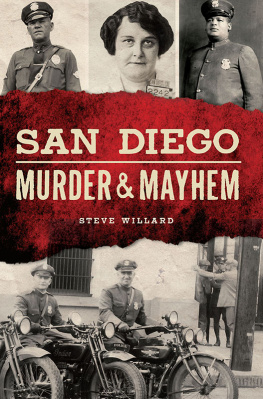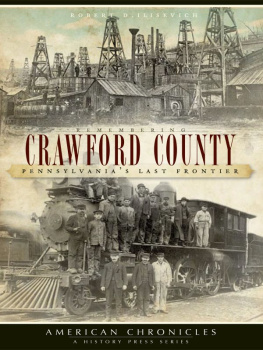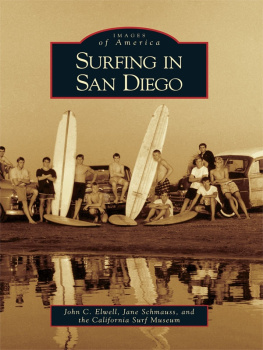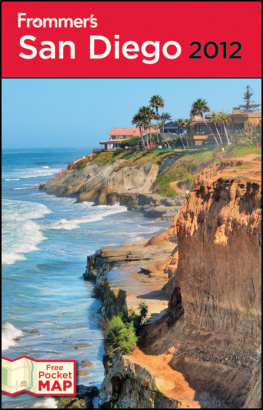
Published by The History Press
Charleston, SC 29403
www.historypress.net
Copyright 2013 by Richard W. Crawford
All rights reserved
Cover images: Images on top of front and bottom of back from Special Collections, San Diego Public Library.
First published 2013
e-book edition 2013
Manufactured in the United States
ISBN 978.1.62584.044.8
Library of Congress Cataloging-in-Publication Data
Crawford, Richard W. (Richard William)
San Diego yesterday / Richard W. Crawford.
pages cm
Includes index.
print edition ISBN 978-1-60949-976-1
1. San Diego (Ca.)--History. 2. San Diego (Ca.)--Social life and customs. I. Title.
F869.S22C736 2013
979.4985--dc23
2013017983
Notice: The information in this book is true and complete to the best of our knowledge. It is offered without guarantee on the part of the author or The History Press. The author and The History Press disclaim all liability in connection with the use of this book.
All rights reserved. No part of this book may be reproduced or transmitted in any form whatsoever without prior written permission from the publisher except in the case of brief quotations embodied in critical articles and reviews.
CONTENTS
PREFACE
San Diego is a city with an extraordinary history. Founded by Spanish missionaries in 1769, this birthplace of California has grown from an impoverished frontier seaport to become the eighth-largest city in America. In the nearly two and a half centuries in between, the region has seen bitter war and restless peace, civic pride and municipal scandal, gifted leaders and bizarre personalities. Many of the more fascinating stories from this history are recounted here in San Diego Yesterday.
Like a predecessor volumeThe Way We Were in San Diegothe articles here first appeared in a weekly newspaper column for the San Diego Union-Tribune. They are presented here in their original length, often with added historical photographs. Many individuals and institutions have generously provided reference help and historical images for this volume. I would like to thank the Naval Historical Foundation; Robert Ray, Special Collections, San Diego State University Library; Ronald W. Evans, San Diego State University; Steve Willard and Tom Giaquinto, San Diego Police Museum; Steven Coy, Special Collections, University of CaliforniaSan Diego; Bruce Semelsberger, Pacific Southwest Railway Museum; Carol Myers and Natalie Fiocre, San Diego History Center; Sarah Hartwell, Rauner Special Collections, Dartmouth College; Robert Finch, San Diego Electric Railway Association; Lisa Glandt, Vancouver Maritime Museum; and Therese Garcia, Portuguese Historical Center. Individuals who have kindly provided from their own collections include Jeff Madruga, Lucile Madruga and Bob and Tennie Bee Hall. I am sincerely grateful to you all.
PART I
A FRONTIER PORT BECOMES A CITY
THE HORTON HOUSE
The great need of this town is about to be supplied by A.E. Horton, Esq., who will immediately erect, on the northwest corner of Fourth and D Streets, a palatial brick edifice, for hotel purposes. It is to contain a hundred rooms and to be fitted up with elegant furniture and all modern improvements.
San Diego Bulletin, December 18, 1869
San Diego in 1869 was on the verge of a boom. A railroad connection to the east, which would make San Diego the terminus of the first transcontinental railroad, seemed likely. Anticipating the link, real estate sales boomed. The Bulletin declared, From a place of no importance, the home of a squirrel a few months back, we now have a city of three thousand inhabitants.
Only two years earlier, a businessman from San Francisco, Alonzo Erastus Horton, had started it all by buying San Diego pueblo land near the portnot far from the failed town site of William H. Davis, whose 1850s venture was already known as Davis Folly. Horton succeeded by selling off lots of Hortons Addition at bargain prices to attract settlers and businesses. For many investors, the impending arrival of the railroad clinched the deal.
On New Years Day 1870, Horton broke ground for a first-class hotel that would be the centerpiece of the rising city. A shipload of rough lumber was promiscuously dumped around a brush-covered site on D Street, and nearly all the carpenters and bricklayers in town set to work. Hortons brother-in-law, W.W. Bowers, supervised the construction of the hotel, working from a crude sketch of San Franciscos famed Russ House as a model. The two-and-a-half-story, one-hundred-room hotel was finished in only nine months at the cost of $150,000.

Alonzo Erastus Horton, builder of the Horton House. Special Collections, San Diego Public Library.
The Horton House opened on October 10, 1870, to rave public reviews. Calling itself the largest and finest hotel in California south of San Francisco, it featured gas lighting and rich carpeting throughout the building, rooms with steam heaters and marble washstands filled with pure soft water conveyed by pipes (from a well) and bathrooms running both hot and cold water. Perhaps the hotels proudest achievement was an electrical bell apparatus, with wires, which ran to the office from every room.
The hotel soon operated at capacity and brought new business to San Diego. Hotel guests paid $2.50 for a room, meals included. The San Diego Union noted that Horton has met the great need of our young city. He did it by building and keeping a first class hotelthe Horton House has done more for San Diego than all other improvements combined.
Horton kept the ownership of the hotel for several years, but only with difficulty. In 1873, the railroad syndicate that had promised a terminus in San Diego collapsed. San Diegos boom faltered, and Horton found himself in financial trouble. He leased the Horton House and looked, unsuccessfully, for a buyer of the hotel. He also borrowed money, using his hotel as collateral. When Horton defaulted on a loan from a local businessman, he almost lost the property.

San Diegos Horton House, the finest hotel in California south of San Francisco, opened in October 1870. Special Collections, San Diego Public Library.
In M.S. Patrick v. A.E. Horton, it was alleged that $4,107 was owed to Mr. Patrick. To satisfy the debt, the district court issued a writ of attachment that demanded that Horton surrender all the furnishings of the hotel. Horton survived the crisis, but the court case file, which contained a room-by-room inventory of the Horton House, provided lavish evidence of the best style for which the hotel was known.
The attachment papers listed the contents of every room: hotel office, sleeping rooms, bar, library, billiard room and dining room. The most minimal bedroom contained a bedstead with sheets, pillows and blankets, as well as towel racks, chamber pot, spittoon and chair. More sumptuous quarters added loungers and rocking chairs. Some rooms boasted pianos, marble center tables and oil paintings on walls. The hotel bar was well stocked with nearly one hundred varieties of liquor and several thousand cigars.
For several more years, Horton leased out the hotel while he struggled with mortgage payments, but foreclosure loomed. Finally, in August 1881, the
Next page

















